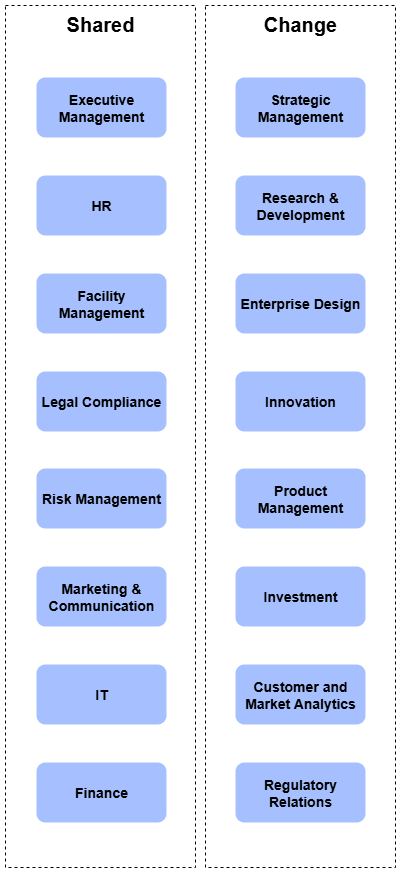No edit summary |
No edit summary |
||
| (3 intermediate revisions by the same user not shown) | |||
| Line 1: | Line 1: | ||
<small>[[Capability Modeling Guidelines|Capability Modelling Guidelines]] | [[Capability_Modeling_Guidelines:_How_to_Structure_a_Capability_Map|How to Structure a Capability Map]]</small> | <small>[[Capability Modeling Guidelines|Capability Modelling Guidelines]] | [[Capability_Modeling_Guidelines:_How_to_Structure_a_Capability_Map|How to Structure a Capability Map]]</small> | ||
=Identify | =Identify shared and change capabilities= | ||
Setting up shared [[capabilities]] reduces redundancy, ensures consistency, and enhances adaptability across an [[organisation]]. Instead of different teams reinventing the wheel with siloed solutions, shared [[capabilities]] provide standardised [[activities]] such as finance, HR, or IT. Reusing these [[capabilities]] ensures standardisation and efficiency. By eliminating duplication, they also optimise costs while allowing teams to focus on specific customer-focused or operational [[activities]]. | Setting up shared [[capabilities]] reduces redundancy, ensures consistency, and enhances adaptability across an [[organisation]]. Instead of different teams reinventing the wheel with siloed solutions, shared [[capabilities]] provide standardised [[activities]] such as finance, HR, or IT. Reusing these [[capabilities]] ensures standardisation and efficiency. By eliminating duplication, they also optimise costs while allowing teams to focus on specific customer-focused or operational [[activities]]. | ||
Introducing | Introducing 'change' as a separate category is essential to clarify where and how much you invest in 'running the business' versus 'changing the business'. [[Enterprise Design]], research & development, or product design are typical change [[capabilities]]. | ||
Identifying existing shared [[capabilities]] is usually much easier than diving into the specialised details of a complex [[enterprise|enterprise’s]] operations. Typical examples, such as marketing, finance, IT, and legal, can often be found simply by consulting the [[organisation]] chart or the [[process]] model (support [[processes]]) available on the intranet. | Identifying existing shared [[capabilities]] is usually much easier than diving into the specialised details of a complex [[enterprise|enterprise’s]] operations. Typical examples, such as marketing, finance, IT, and legal, can often be found simply by consulting the [[organisation]] chart or the [[process]] model (support [[processes]]) available on the intranet. | ||
| Line 13: | Line 13: | ||
[[File: CGM_Shared_and_Change_Capabilities_1.png]] | [[File: CGM_Shared_and_Change_Capabilities_1.png]] | ||
==Practical | ==Practical tips== | ||
'''Don’t dive deep.''' | '''Don’t dive deep.''' | ||
| Line 21: | Line 21: | ||
Wait until you have the mandate to optimise or redesign a particular shared [[capability]] before going into more detail. | Wait until you have the mandate to optimise or redesign a particular shared [[capability]] before going into more detail. | ||
'''Introducing | '''Introducing 'change' as a category can be challenging.''' | ||
Introducing | Introducing 'change' is crucial to clarify the distinction between investing in 'running the business' and 'changing the business'. [[People]], however, are often accustomed to thinking in the categories used by widespread methods such as process management ('management', 'operational', and 'support' [[processes]]). Expect conflicts when shifting from a 'management' mindset to a 'change' perspective. | ||
<br><br> | |||
{| style="width:100%;" | |||
| style="text-align:left; width:50%;" | [[Capability_Modeling_Guidelines:_Reused_Capabilities|← Previous page]] | |||
| style="text-align:right; width:50%;" | [[Capability_Modeling_Guidelines:_Clear_Names_and_Descriptions|Next page →]] | |||
|} | |||
Latest revision as of 13:48, 13 September 2025
Capability Modelling Guidelines | How to Structure a Capability Map
Setting up shared capabilities reduces redundancy, ensures consistency, and enhances adaptability across an organisation. Instead of different teams reinventing the wheel with siloed solutions, shared capabilities provide standardised activities such as finance, HR, or IT. Reusing these capabilities ensures standardisation and efficiency. By eliminating duplication, they also optimise costs while allowing teams to focus on specific customer-focused or operational activities.
Introducing 'change' as a separate category is essential to clarify where and how much you invest in 'running the business' versus 'changing the business'. Enterprise Design, research & development, or product design are typical change capabilities.
Identifying existing shared capabilities is usually much easier than diving into the specialised details of a complex enterprise’s operations. Typical examples, such as marketing, finance, IT, and legal, can often be found simply by consulting the organisation chart or the process model (support processes) available on the intranet.
Change capabilities are often not explicitly categorised as such; instead, they are typically embedded within support processes or hidden in the description of an organisational unit or process.

Practical tips
Don’t dive deep.
There is usually a broad understanding of what the shared capabilities entail. When creating an initial high-level overview of the enterprise’s capabilities, it is sufficient to stay at level 1 and avoid diving deeper.
Wait until you have the mandate to optimise or redesign a particular shared capability before going into more detail.
Introducing 'change' as a category can be challenging.
Introducing 'change' is crucial to clarify the distinction between investing in 'running the business' and 'changing the business'. People, however, are often accustomed to thinking in the categories used by widespread methods such as process management ('management', 'operational', and 'support' processes). Expect conflicts when shifting from a 'management' mindset to a 'change' perspective.
| ← Previous page | Next page → |